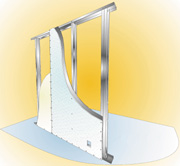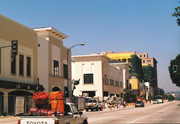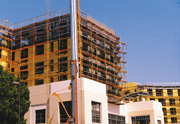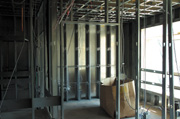

It's also being made safer.
The multiple-building project is complying with tighter windload and seismic shear panel codes set following the 1994 Northridge earthquake. Shear value is the amount of total load going into the wall, divided by the length of the wall. And Paseo Colorado is meeting unusual demands as mixed-use structures.
"It is a unique project in that all of these apartments are on top of retail space," says Michael Berger, vice president of operations for Berger Brothers, the wall and ceiling contractor on the job.

Stick to steel
"The project had called for shear, of course. Because we're framing all of the residential out of metal studs, we had to come up with a way to shear the building," says Berger. "The general contractor didn't want structural steel. He wanted all the shear to come from the system we were providing. At the same time, the city didn't want any plywood on the building. Normally you would obtain your shear values from wood sheathing."The system Berger Brothers provided was a composite of 22-gauge sheet steel and gypsum board, called Sureboard Structural Panels. Developed by the engineering firm of Swartz & Kulpa, of Tustin, Calif., Sureboard resists seismic force and windload that are imposed on structures.
"Whenever engineers design a building, they look at how much wall they have in the building to resist wind and seismic loads," explains Greg Kulpa, principal in the firm. "Depending on the location of the building and how much wind and earthquake load it receives, they calculate the amount of load that goes to each wall. Sometimes the shorter the wall the higher the strength needs to be depending on how the load is transferred around the building."
Sureboard was tested by Dr. Reynaud Serrette, project director for the Light Gauge Steel Research Group at Santa Clara University in California. After the Northridge earthquake, old shear wall testing criteria were discarded. Serrette developed the testing criteria for metal-stud shear wall design for the American Iron and Steel Institute, establishing the new codes that determined shear values for steel-stud framing and structural panels. Based on Serrette's testing, Sureboard received ICBO accreditation in the form of ER-5762.

Less work
Sureboard, which is also available with a wood backing, offers a replacement to traditional flat strap or cross bracing, which involves plates and a large number of screws. "The design was based on the cross bracing's being properly tensioned," says Tom Porter, executive vice president of CEMCO, manufacturer of Sureboard. "After the roof got loaded, it would loosen again--not to mention the fact it was extremely labor intensive to install. It left a lot of bulges in the drywall at the gusset plates because of the number of screws they had to use.""Because of the size of the project, the number of floors and the sheer mass of the building, cross bracing would not have provided the proper amount of shear," says Berger.
Sheer mass and shear value made Sureboard a logical choice for the project. It arrives at the job site from the CEMCO plant in City of Industry, Calif., in 4-foot-by-8-foot or 4-foot-by-10-foot sheets, the wallboard already attached to the steel sheets with industrial-strength glue. By the time the project is finished, 360,000 square feet of Sureboard--100,000 for the exterior and 260,000 for the interior--will have been shipped.
"Installing Sureboard is no different from installing regular wallboard," Porter says. "The difference is that you are getting shear value with the composite board, instead of just a regular sheet of wallboard."
CEMCO provided installation training to the Berger crew, who took only a short time getting past the learning curve. Still, Berger takes a more critical view of the installation than Porter.
"It's more difficult than installing drywall because you're screwing through a full sheet of metal on the back of it," explains Berger. "If you have to cut out an electrical receptacle or something like that, you first have to take a skill saw and cut through the steel on the backside, then you have to cut the drywall on the front side."
Once the challenging aspects of installation were mastered, the crew appreciated Sureboard's benefits.
"Because all of the interior walls will eventually be painted drywall, if you used plywood to obtain your shear value, you would have to put drywall on top of the plywood," Berger says. "Sureboard, on the other hand, accounts for the thickness of the plywood in the non-sheared wall.
"You're getting your shear and hanging your drywall at the same time," he goes on to say. "So while it's harder to install than plywood, you're saving the step of not having to install your drywall over your plywood. In addition, shear value from Sureboard is double that of plywood, so you have to install only half the amount of Sureboard to obtain the same amount of shear. All in all, it's a labor savings."
It also could spell the answer to the many challenges of constructing in seismically threatened areas.
"Contractors were asking for a product that was stronger than the current technologies but also provided ease of installation," says Kulpa. "It's so simple. It's just sheething board and metal. But it's solving a lot of problems that are being experienced by the metal framing contractors that are out there."
